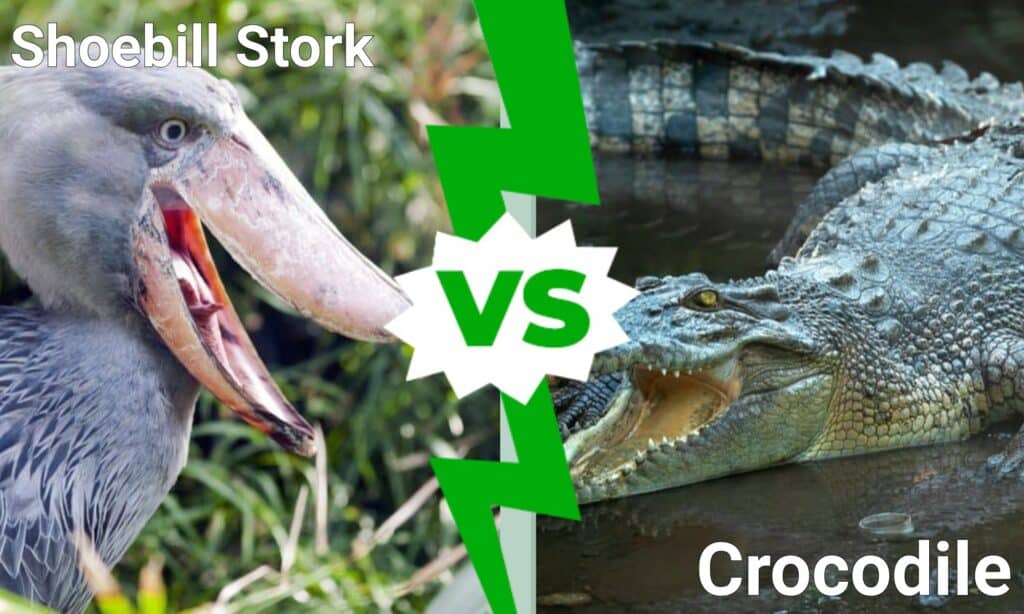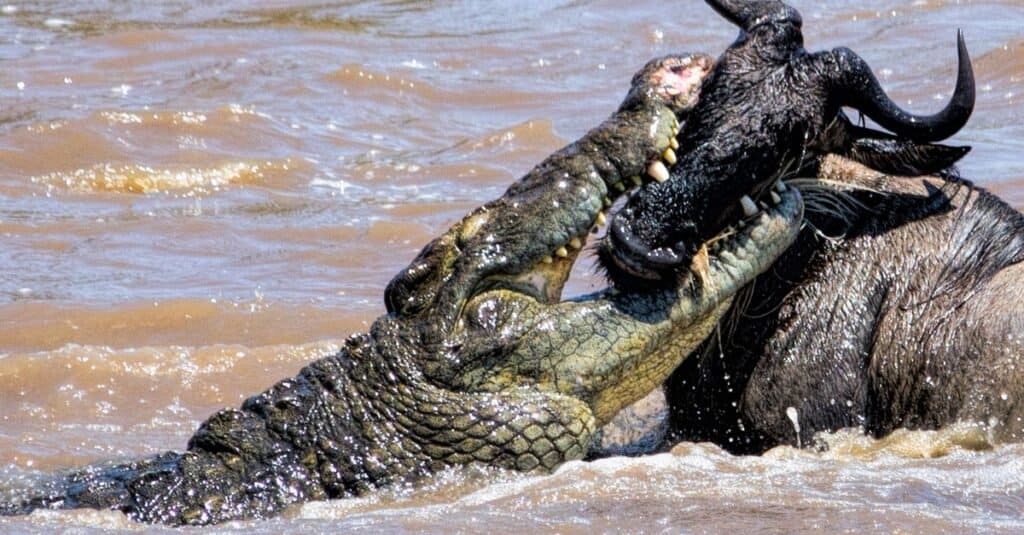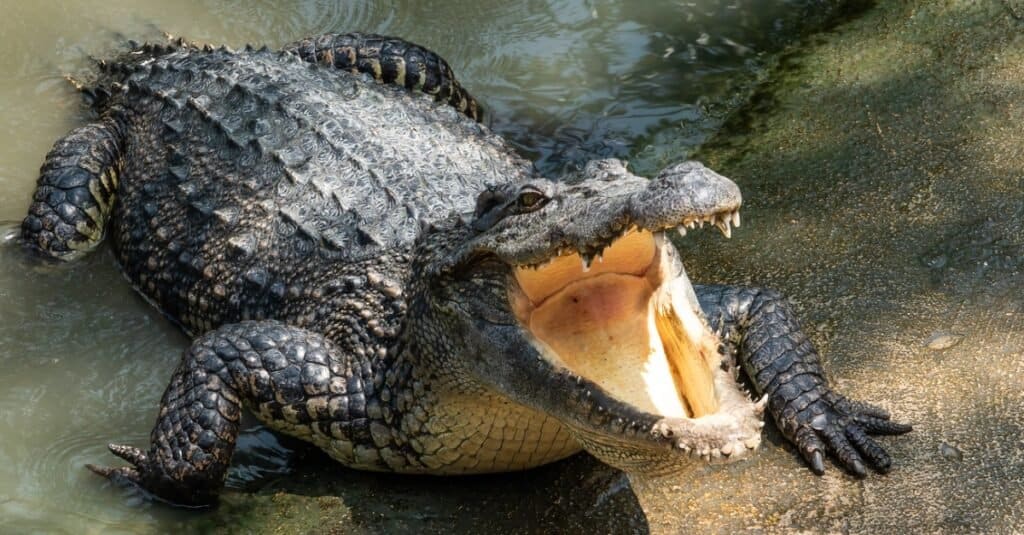Crocodiles are known as apex predators in their range. They may just be the deadliest reptiles alive today. That doesn’t make crocodiles invincible, though. Shoebill storks are tall, strong birds with large bills, sharp beaks, and a penchant for eating fish and other large aquatic animals, including juvenile crocodiles. So, what would happen in a shoebill stork vs. crocodile fight? That’s what we’re going to discover today. By closely looking at the animals, we’ll determine which of them has a better chance of surviving in combat.
Comparing a Shoebill Stork and a Crocodile

| Shoebill Stork | Crocodile | |
|---|---|---|
| Size | Weight: 8lbs-15lbs Height: 3.5-4.5ft, possibly up to 5ft | Weight: 300-2,000lbs Length: 10ft – 20ft |
| Speed and Movement Type | – 30 mph while flying | – 22 mph on land – Very fast crawling motion – 15 mph in water propelled by its tail |
| Attacking Method | – Lunges at prey and pierces it with its sharp beak – Will use the edge of its 7-inch bill to clip pieces off of prey | – 3,700PSI bite power – Incredibly powerful bite – Death roll can instantly remove large chunks of flesh – 4-inch teeth – 66 teeth |
| Defenses | – Flight – Has large stature that scares off some potential predators | – Tough skin – Ability to travel on land and water – Potential resistance to some elapid venoms – Speed |
| Predatory Behavior | – Ambush predator that waits motionless before prey gets close enough to attack. | – Ambush predators that wait in the water for prey to approach before attacking |
What Are Key Differences Between a Shoebill Stork and a Crocodile?

A shoebill stork will stand still in the wetlands waiting for prey.
©Petr Simon/Shutterstock.com
The greatest differences between a shoebill stork and a crocodile are size and morphology. A shoebill stork is a tall bird with a long bill that stands up to 5ft tall and weighs up to 15lbs, but a crocodile is a large reptile with a long snout that weighs upwards of 2,000lbs and grows 10ft-20ft in length.
These animals could not be more different from one another in terms of their bodies. They do have some similarities, though. Either way, we have to carefully examine other facets of these animals to get a better idea of how a battle between them would pan out.
What Are the Key Factors in a Fight Between a Shoebill Stork and a Crocodile?

Crocodiles are immensely powerful reptiles with great physical defenses.
©Phil Hyde/Shutterstock.com
The key factors in a battle featuring a shoebill stork and a crocodile include attacking methods, defenses, size, speed, and predatory behavior. In the following section, we will break down each of those elements and name the creature that has the advantage over the other.
Shoebill Stork vs. Crocodile: Size
Crocodiles are larger than shoebill storks, but they’re shorter than them overall. A crocodile weighs up to 2,000 lbs and grows between 10ft and 20ft long. However, it only stands a few feet off the ground at most.
The shoebill stork doesn’t weigh a lot. They tend to top out at 15 lbs and stand up to 5ft tall, but that height is not too common.
All in all, crocodiles have a size advantage against the shoebill stork.
Shoebill Stork vs. Crocodile: Speed and Movement
The shoebill stork can technically move faster than the crocodile by way of flight, but the crocodile is far quicker on the ground. The bird is known for its slow, methodical movements when approaching prey on the ground, often standing still until its prey is close by to swoop in and attack.
The shoebill stork can fly at roughly 30 mph, and some crocodile species can scamper at 22 mph on land for brief periods and swim at 15 mph.
The shoebill stork has the speed advantage, but the crocodile has the advantage when they’re both on the ground.
Shoebill Stork vs. Crocodile: Attacking Methods
The shoebill stork uses its sharp beak and bill to attack prey. The animal lunges at prey and either pierces it with its sharp beak or uses the edge of its sharp bill to slice parts off its body. The large, 7-inch bill on the stork, along with its successful attacking technique, allows it to overcome monitor lizards and large fish.
These attacking methods and the shoebill stork’s size make this bird one of the creepiest animals in the world!
The crocodile has a powerful method of attack, too. Crocodiles have a biting power that reaches 3,700PSI. Their teeth range up to 4 inches in length, and they’re designed to hold prey in place while they chomp on their prey.
Crocodiles can also bite and perform a death roll, which involves biting and rolling to rip off chunks of flesh or entire limbs.
Crocodiles have a far deadlier and more powerful attacking method.
Shoebill Stork vs. Crocodile: Defenses
The shoebill stork’s size will keep some prey away, but it’s the bird’s speed that truly keeps it safe. These birds can fly at 30 mph, easily taking off and leaving an area that isn’t safe. They don’t always lift off in time to avoid danger, though.
Crocodiles are stuck on the ground, but they can move on land and water, giving them protection in two areas. Also, crocodiles have their immense size, tough skin, and potentially some resistance to snake venom to keep them safe.
Crocodiles have an advantage in terms of defense.
Shoebill Stork vs. Crocodile: Predatory Behavior
The shoebill stork and the crocodile are both patient ambush predators. Crocodiles will either wait completely underwater or, with just their eyes above the waterline, creep up on prey and then quickly grab it at the water’s edge. Any animal that has to take a drink out of crocodile-infested waters is in tremendous danger.
Crocodiles use their weight to drag the animal into the water to drown or disorient the prey and then bite it to death.
Shoebill storks will stand in the water or close by the water, waiting for something to swim or slither by. When a creature gets close, the statuesque creature lashes out and grabs the prey.
Both shoebill storks and crocodiles have very similar, effective predatory methods.
Who Would Win in a Fight Between a Shoebill Stork and a Crocodile?

Crocodiles are too large and powerful for a shoebill stork to overcome.
©AppleZoomZoom/Shutterstock.com
A crocodile would win a fight against a shoebill stork. The size, power, and brutal ambush techniques of crocodiles give them a massive advantage against these birds.
You may have heard stories about a shoebill stork killing and eating crocodiles. Sure, this bird can eat a baby and perhaps some juvenile crocodiles. However, they are certainly not capable of killing a fully-grown crocodile.
The shoebill stork is a powerful animal that eats fish and most reptiles with ease. In this case, though, the shoebill stork can’t overcome the defenses of the crocodile. Disregarding the potential for ambush attacks that favor the crocodile outright, the fight would take place in shallow water.
The shoebill has to get close to the crocodile to attack. Unless it was attacking from the air, such an attack puts the animal too close to the crocodile to avoid counterattacks. The shoebill might be able to peck and harm the crocodile some, but it would take forever to kill the crocodile in this way.
Meanwhile, the crocodile only needs to grab ahold of the bird once, and it will have the animal. The crocodile would grab and drag the unfortunate bird to the ground and completely overwhelm it. The shoebill stork might cause some damage, but it’s going down in this fight.
What Can Beat a Crocodile?
Crocodiles are some of the most feared creatures in the animal kingdom. They have been around since prehistoric times, and they remain a force to be reckoned with today. But from time to time, there is always speculation as to which animals could potentially win in a fight against a crocodile. After all, can anything really kill this mighty creature?
The answer may surprise you. Yes! There are actually a few animals that have been known to defeat crocodiles in battle. For example, African lions and leopards have both proven capable of killing these reptiles and eating them, though this is rare. Perhaps prehistoric predators such as saber-toothed cats or Tyrannosaurus Rex might stand a chance against them!
But what about something even smaller than any of these fearsome beasts? Could a tiny virus or bacteria do any damage to the scaly armored skin of the croc? The truth is that while viruses and bacteria can’t physically harm it directly, they can make it very sick if contracted by one, leading either way to its eventual death if not treated properly. So perhaps a small virus could win out over this powerful reptile when push comes to shove!
The photo featured at the top of this post is © iStock.com/Michel VIARD
Thank you for reading! Have some feedback for us? Contact the AZ Animals editorial team.






